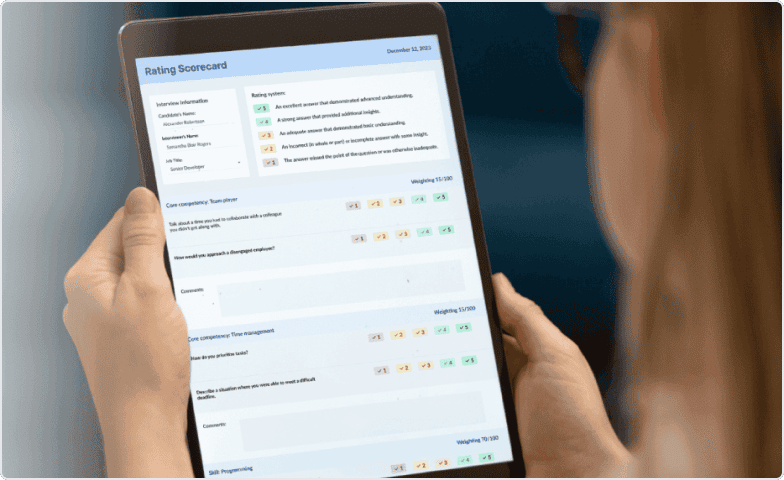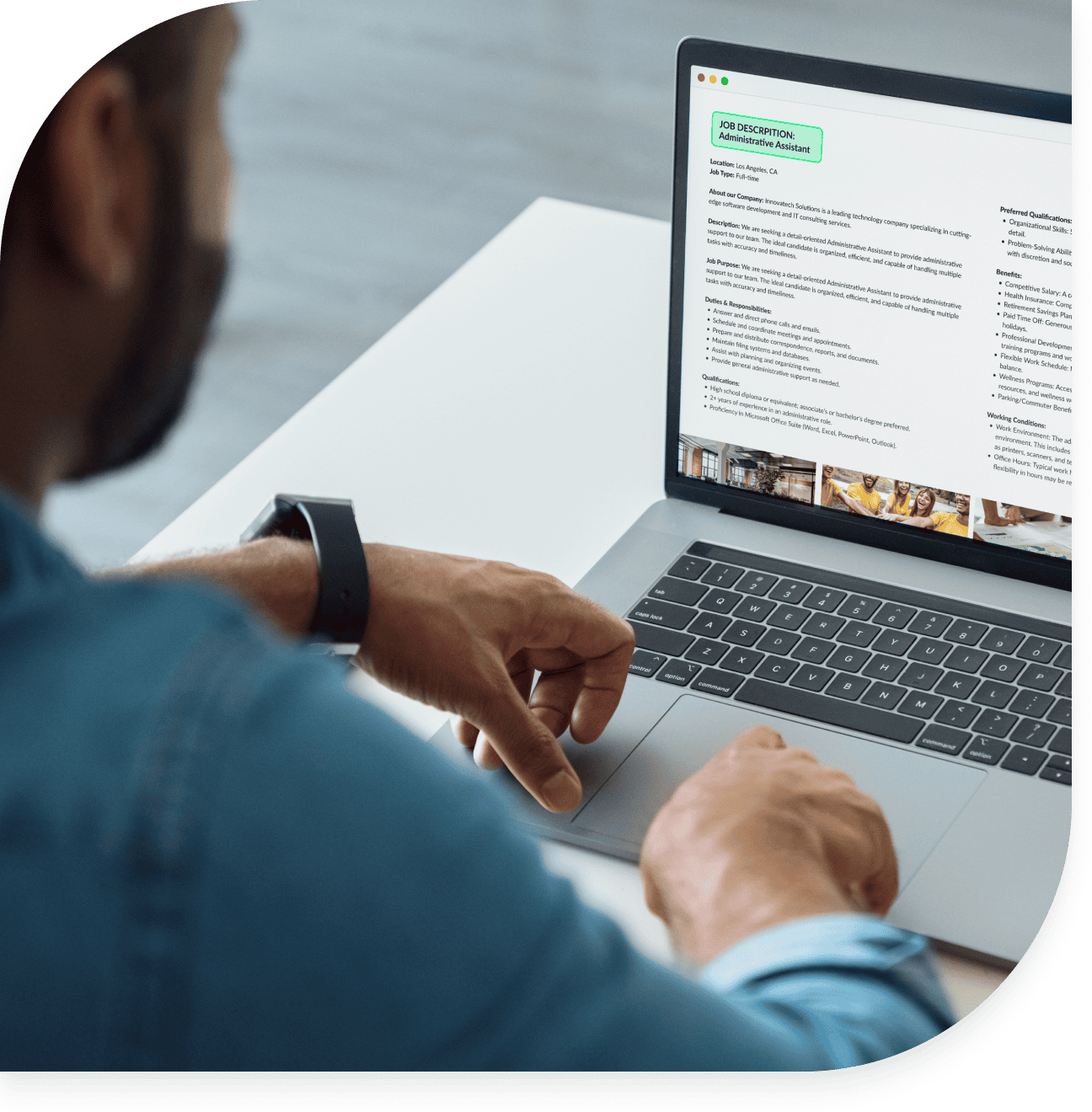
What Is An Interview Scorecard?
Discover what an interview scorecard is, its benefits, and how to use it to interview effectively.

Whether you are a team leader, a hiring manager, or a business owner, there will likely come a time in your career when you will need to create a new job position. One of the first steps in this process is creating a job description. If you need help figuring out where to start or how to write an effective one, you have come to the right place.
This guide will help you understand the importance and purpose of job descriptions. You will also get tips and a template for how to put together an effective job description that will attract the best candidates for the position.
A job description is like a recipe. However, instead of defining the ingredients, steps, and equipment required to make a dish, a job description details the job responsibilities, tasks, skills, and qualifications required for a particular role. It also outlines how it aligns with the company's mission and goals.
You might be most familiar with job descriptions as a tool for advertising job vacancies, but they fulfill many objectives. Here are just a few goals that a solid job description should accomplish.

Job descriptions are versatile tools for employers because they can use them externally and internally. Externally, they attract and recruit suitable candidates by clearly outlining the role, requirements, and why they should work for your company. Internally, they guide employees on their duties, help measure performance, and support training and development.
They also ensure transparency by illustrating how each role fits into the bigger picture and contributes to the company's goals. Finally, they can promote inclusion by providing a standard reference that helps ensure all employees are treated fairly and equitably, regardless of their background.
Language matters and certain biased terms could inhibit specific individuals or even entire groups of people from applying to your roles. For example, minimizing gendered words can help ensure your job descriptions don’t unintentionally filter out qualified candidates of the opposite gender. Additionally, age and cultural bias can creep in with terms like “digital native” (which implies youth) or “native English speaker,” which may discourage fluent, non-native speakers from applying.
While there is room for creativity, every effective job description needs certain critical components to set clear expectations, avoid confusion, and ultimately attract the best-fit candidates for the job. Here are the key ingredients every job description should have.
A job title should clearly outline the job's responsibilities. Like the headline of a news article, it needs to be catchy and informative. It should help both job seekers and employers quickly understand the position.
When creating a job title, be clear and specific. The title should indicate the seniority level of the position and use standard industry terms. For example, "Marketing Manager" is better than "Growth Guru." Stick to more straightforward titles that candidates are more likely to search to attract the best applicants.
The job purpose explains why the job exists and how it contributes to the company's goals. It acts as a mission statement for the role, giving context and meaning to daily tasks, which helps potential candidates understand the bigger picture and see how their work will make a difference.
The job purpose section should be clear, specific, and concise—just like a job title. One to two sentences are usually enough. It should also be written in a positive and motivating tone, but not be so overly grandiose that it doesn't accurately reflect the role.
Job duties and responsibilities outline what an employer expects an employee to do regularly, from daily tasks to year-over-year objectives. This section should help candidates better understand the role's requirements and assess if they have the necessary skills and experience.
Be sure to list the most important duties first so candidates know what the job mainly involves. You could also use percentages to show the priority level for each responsibility. Also, be realistic about what the employee can achieve in a typical workday or workweek. Too many tasks may turn off potential candidates.
What does Gen Z look for in a job description?
According to a 2023 report from Symplicity Recruit, the top three turn-offs for Gen Z candidates are lack of clarity about the role and responsibilities (66%), too many unrealistic job qualification requirements (65%), and no specific salary range (53%).
Every job requires a particular set of skills, experience or education to perform effectively. This section outlines these qualifications so candidates can determine if they meet the essential criteria for the role and employers can attract the most qualified candidates.
An example of an education qualification would be a "high school diploma or equivalent" or a "Bachelor's degree in journalism or communications." Experience could look like "3 years of experience in human resources" or "Previous sales experience preferred." Lastly, skills could be "Proficiency in Final Cut Pro" or "Strong communication skills."
Make it clear which qualifications are essential and which are preferred. Also, ensure the qualifications match the job level. For instance, it’s not reasonable to ask for ten years of experience for an entry-level position.

Skills over schools?
According to global LinkedIn data, between 2019 and 2022, there was a 36% increase in paid job posts that omit degree requirements. The industries that are seeing the fastest growth rate in skills-first hiring are financial services, accommodation and food services, and technology, information, and media.

Outside of education, experience, and skills, you may include other preferred qualifications, such as industry or role-related certifications (e.g., Project Management Professional (PMP) for a project management position, language proficiency, or unique project experience (e.g., "led a successful virtual event series").
Working conditions include the work schedule, physical environment, travel requirements, remote or hybrid work options, and safety considerations. When writing this section, aim to be transparent and realistic. You can highlight unique benefits or perks but don’t downplay any potential challenges. You should also mention if there are accessibility accommodations for employees with disabilities or other special needs.
Having trouble knowing where to start with writing your job description? We’ve included a template below so you can have the basic layout of what your job description should look like.
A job description can set the tone for the whole hiring process. It may even be an applicant’s first touchpoint with your company, so you need to get it right. To start your relationship off on the right foot, aim to be as clear, specific, and concise as possible.
Put yourself in a job seeker's shoes. What would they want to know about the role? What skills and experience are essential, and what are just nice-to-haves? Job descriptions are about finding the right fit and matching the company's needs with the candidate's skills and aspirations, so be realistic and avoid exaggerating the positives or leaving out key details.
Lastly, remember that job descriptions aren't set in stone. They can evolve as the company's needs and roles change. So, be open to feedback and update it regularly to ensure it’s still accurate and relevant.

The five core elements of a job description are the job title, job purpose, job duties and responsibilities, required qualifications, and work conditions. These key elements help employers attract the best-fit and most qualified candidates. They also help job seekers assess whether they are a good match for the role and see if it aligns with their needs, goals, and lifestyle.
There are four overarching types of job descriptions: generic, specific, performance-based, and functional or task-based. The generic type gives a broad overview of the job and company. Specific descriptions dive deep into the skills required for the role. Performance-based descriptions focus on the end goal or job purpose, while functional or task-based ones focus more on day-to-day duties.
The best person to write a job description is usually the manager or supervisor in charge of that role, as they are most familiar with the job's requirements and responsibilities. However, the HR team may help refine it further. The manager or supervisor may also seek input from current employees in similar roles, senior management, or external consultants.
Modernize your hiring process with expert insights and advice.